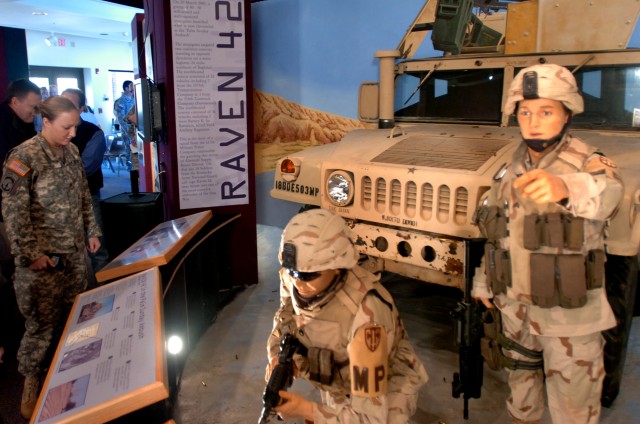FORT LEE, Va. - The U.S. Army Women's Museum showcases the most recent chapter of how women have contributed to the military with its Global War on Terrorism exhibit.
The exhibit's centerpiece is a life-size diorama of the actions of Sgt. Leigh Ann Hester and the other members of her squad during a March 20, 2005, ambush by insurgents near Baghdad.
Hester, who was assigned to the Kentucky Army National Guard's 617th Military Police Company at the time, was awarded the Silver Star Medal, becoming the first woman to receive the award since World War II and the first woman to ever receive it for direct actions against an enemy force.
Others in the unit received the Silver Star including Staff Sgt. Timothy Nein, the squad leader, whose award has recently been upgraded to a Distinguished Service Cross, the second-highest award for valor.
The Women's History Museum originally opened as the Women's Army Corps Museum at Fort McClellan, Ala., in 1955, and was relocated to Fort Lee near Petersburg, Va., in 2000.
Hester and most of the other members of the Kentucky squad were present for the opening of the GWOT exhibit Feb. 3. It was the first time they had all been together in more than a year, Hester said.
While the exhibit, which opened three weeks prior to March 1, the start of Women's History Month, focuses on the actions of Hester and Nein, both Soldiers emphasized that the entire squad worked together to achieve success in the mission.
"It wasn't one person's actions that day," Hester said. "It was us as a team. You know, I wouldn't be standing here today without these guys having had my back that day."
The squad, call sign Raven 42, was escorting a convoy near the town of Salman Pak south of Baghdad when the convoy came under heavy fire. Acting without hesitation, the Guard Soldiers drove their vehicles between the insurgents and the convoy. Hester and Nein dismounted from their armored Humvees and led the counterattack against the ambush. Twenty-seven insurgents were killed and seven were captured.
Two Soldiers in the squad were wounded during the engagement, which lasted roughly 30 minutes. But it could have been far worse because the insurgents had getaway vehicles pre-positioned with open doors and trunks as well as handcuffs which, some say, indicates they intended to take prisoners.
While Hester was quick to downplay her role during the counterattack, others feel she did much more than simply her job.
"It's amazing," said Pat Sigle, director of the Army Women's Foundation, which oversaw the funding for the exhibit. "To her it was her job. That's all it was, that's her job. I hope she understands, and I think in time she will, just how amazing that team was, how they all came out alive, how they pulled together and did what they were supposed to do."
The fact that Hester is a woman who has served in a combat zone, and in direct combat action, has been highlighted by many people. But it wasn't anything out of the ordinary to her. It was just another aspect of the squad.
"I believe everybody in my squad changed a lot of minds," she said. "Not just me. We're a blend of several different cultures, and being a woman, to me, is just one of those cultures. It makes no difference. If you can do the job, you can do the job. Some people can and some people can't."
Others in the squad agreed.
"A hundred years ago I guarantee our forefathers would never have thought a squad that was as successful as we were that day could come from so many different backgrounds and look so different physically," said Sgt. Jason L. Mike, an African-American medic assigned to the unit who was also awarded the Silver Star for his actions that day.
While many in attendance expressed awe at the actions of Hester, Nein, Mike and the others in Raven 42, the squad members stood in awe of the exhibit that depicts their actions.
"They did an outstanding job," said Hester. "It's amazing what they did. I believe it captures the actions of March 20, 2005, very well."
But, for Hester, it still comes down to just doing their jobs that day.
"There's a lot of Soldiers that are doing this job right now," she said. "Right this minute, right now they're doing now what we were doing then, and they're not getting the credit they deserve. Look at the big picture. We did great one day, but there are people doing that everyday. Don't lose sight of that."
(Staff Sgt. Jon Soucy serves with the National Guard Bureau.)




Social Sharing